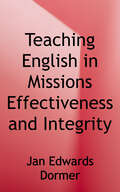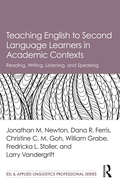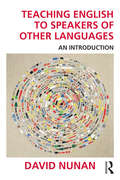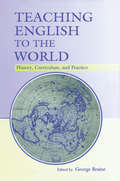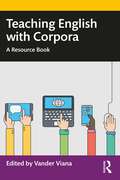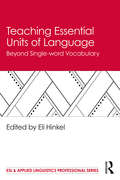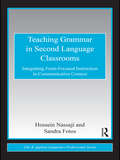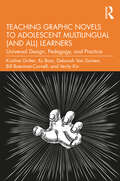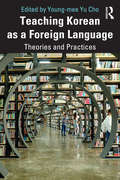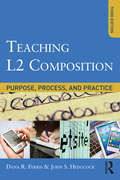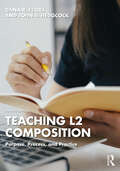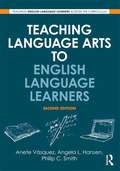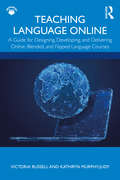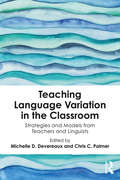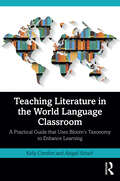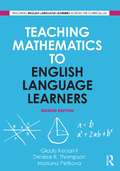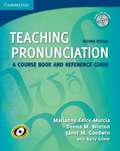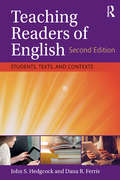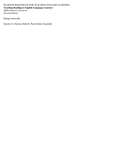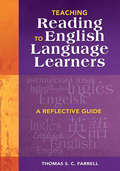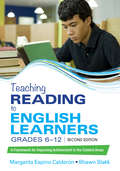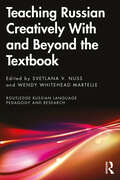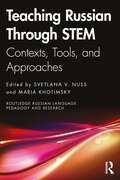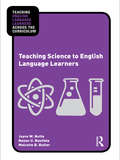- Table View
- List View
Teaching English in Missions: Effectiveness and Integrity
by Jan Edwards DormerEnglish Teaching is common in missions today. However, there has been relatively little discussion on what constitutes effectiveness in English ministries. <p><p>This book aims to foster such discussion. It first addresses issues of concern in English ministries and then suggests criteria for effectiveness, considerations in teacher preparation, and models for the teaching of English in missions.
Teaching English to Second Language Learners in Academic Contexts: Reading, Writing, Listening, and Speaking (ESL & Applied Linguistics Professional Series)
by William Grabe Dana R. Ferris Fredricka L. Stoller Larry Vandergrift Jonathan M. Newton Christine C.M. GohTeaching English to Second Language Learners in Academic Contexts: Reading, Writing, Listening, and Speaking provides the fundamental knowledge that ESL and EFL teachers need to teach the four language skills. This foundational text, written by internationally renowned experts in the field, explains why skills-based teaching is at the heart of effective instruction in English for academic purposes (EAP) contexts. Each of the four main sections of the book helps readers understand how each skill—reading, writing, listening, and speaking—works and explains what research has to say about successful skill performance. Pedagogically focused chapters apply this information to principles for EAP curriculum design and to instructional activities and tasks adaptable in a wide range of language-learning contexts. Options for assessment and the role of digital technologies are considered for each skill, and essential information on integrated-skill instruction is provided. Moving from theory to practice, this teacher-friendly text is an essential resource for courses in TESOL programs, for in-service teacher-training seminars, and for practicing EAP teachers who want to upgrade their teaching abilities and knowledge bases.
Teaching English to Speakers of Other Languages: An Introduction
by David NunanDavid Nunan's dynamic learner-centered teaching style has informed and inspired countless TESOL educators around the world. In this fresh, straightforward introduction to teaching English to speakers of other languages he presents teaching techniques and procedures along with the underlying theory and principles. Complex theories and research studies are explained in a clear and comprehensible, yet non-trivial, manner without trivializing them. Practical examples of how to develop teaching materials and tasks from sound principles provide rich illustrations of theoretical constructs. The content is presented through a lively variety of different textual genres including classroom vignettes showing language teaching in action, question and answer sessions, and opportunities to 'eavesdrop' on small group discussions among teachers and teachers in preparation. Readers get involved through engaging, interactive pedagogical features and opportunities for reflection and personal application. Each chapter follows the same format so that readers know what to expect as they work through the text. Key terms are defined in a Glossary at the end of the book. David Nunan's own reflections and commentaries throughout enrich the direct, up-close style of the text.
Teaching English to the World: History, Curriculum, and Practice
by George BraineTeaching English to the World: History, Curriculum, and Practice is a unique collection of English language teaching (ELT) histories, curricula, and personal narratives from non-native speaker (NNS) English teachers around the world. No other book brings such a range of international ELT professionals together to describe and narrate what they know best.The book includes chapters from Brazil, China, Germany, Hong Kong, Hungary, India, Indonesia, Israel, Japan, Lebanon, Poland, Saudi Arabia, Singapore, Sri Lanka, and Turkey. All chapters follow a consistent pattern, describing first the history of English language teaching in a particular country, then the current ELT curriculum, followed by the biography or the autobiography of an English teacher of that country. This consistency in the structuring of chapters will enable readers to assimilate the information easily while also comparing and contrasting the context of ELT in each country.The chapter authors--all born in or residents of the countries they represent and speakers of the local language or languages as well as English--provide insider perspectives on the challenges faced by local English language teachers. There is clear evidence that the majority of English teachers worldwide are nonnative speakers (NNS), and there is no doubt that many among them have been taught by indigenous teachers who themselves are nonnative speakers. This book brings the professional knowledge and experience of these teachers and the countries they represent to a mainstream Western audience including faculty, professionals, and graduate students in the field of ESL; to the international TESOL community; and to ELT teachers around the world.
Teaching English with Corpora: A Resource Book
by Vander VianaTeaching English with Corpora is an accessible and practical introduction to the ways in which online and offline corpora can be used in English language teaching (ELT). Featuring 70 chapters written by an international range of researchers and practitioners, this book: • provides readers with clear, tested examples of corpus-based/driven lesson plans; • contains activities relevant to English for general purposes and English for specific purposes; • caters for the needs of English language teachers working with learners at different proficiency levels; • features flexible teaching suggestions that can be explored as part of a lesson or as a full lesson. This book is an essential purchase for pre- and in-service English language teachers as well as those studying corpus linguistics in undergraduate/Master’s courses in applied linguistics, ELT and Teaching English to Speakers of Other Languages (TESOL).
Teaching Essential Units of Language: Beyond Single-word Vocabulary (ESL & Applied Linguistics Professional Series)
by Eli HinkelThis textbook provides a practical and research-based foundation for teaching second language (L2) multiword units (also commonly called collocations). Multiword units – such as strong tea, beautiful weather, or would you mind –cannot be readily understood or predicted by the meanings of their component parts, and prove particularly challenging for English language learners. With contributions from top scholars, this text presents a thorough and rounded overview of the principles and practices currently dominant in teaching L2 phrases in a variety of instructional settings around the world. Divided into two sections, Part I examines the pedagogical foundations of teaching the essential units of language. Part II covers a range of techniques and classroom activities for implementing instruction. Intended for students and teacher educators, this accessible volume integrates the key principles, strategies, and applications of current and effective English language instruction for both vocabulary and grammar.
Teaching Grammar in Second Language Classrooms: Integrating Form-Focused Instruction in Communicative Context
by Hossein Nassaji Sandra S. FotosRecent SLA research recognizes the necessity of attention to grammar and demonstrates that form-focused instruction is especially effective when it is incorporated into a meaningful communicative context. Designed specifically for second-language teachers, this text identifies and explores the various options for integrating a focus on grammar and a focus on communication in classroom contexts and offers concrete examples of teaching activities for each option. Each chapter includes a description of the option, its theoretical and empirical background, examples of activities illustrating in a non-technical manner how it can be implemented in the classroom, questions for reflection, and a list of useful resources that teachers can consult for further information.
Teaching Graphic Novels to Adolescent Multilingual (and All) Learners: Universal Design, Pedagogy, and Practice
by Kristine Gritter Xu Bian Deborah Van Duinen Bill Boerman-CornellThis book provides a roadmap for teaching with graphic novels as an effective and engaging approach to advancing reading comprehension for English Learners in secondary schools. Accessibly synthesizing and presenting existing graphic novel research, the authors walk through how to use graphic novels as a teaching tool to improve student motivation and key reading skills, increase their reading proficiency levels, and bolster their vocabulary. The authors provide curricular ideas for teaching multilingual, gifted, and striving readers, along with methods for developing critical literacy and multimodal comprehension. Applying a universal design approach and including examples, current graphic novel recommendations, and pedagogical strategies, this book is essential reading for pre-service teachers in TESOL and literacy education.
Teaching Korean as a Foreign Language: Theories and Practices
by Young-mee Yu ChoTeaching Korean as a Foreign Language: Theories and Practices is designed for prospective or in-service Korean as a Foreign Language (KFL) teachers. With contributions from leading experts in the field, readers will gain an understanding of the theoretical framework and practical applications of KFL education in the context of Second Language Acquisition (SLA). The eight chapters explore the history of and current issues in language education, the practicalities of being a classroom teacher, and teaching and evaluation techniques for developing language and cultural proficiency. This comprehensive volume also includes an annotated bibliography which lists over 500 of the most recent and pertinent research articles and doctoral dissertations in the area. This bibliography will be of great service to students, teachers, and any researchers in applied linguistics and second language acquisition interested in Korean language education.
Teaching L2 Composition: Purpose, Process, and Practice
by Dana R. Ferris John HedgcockThis popular, comprehensive theory-to-practice text is designed to help teachers understand the task of writing, L2 writers, the different pedagogical models used in current composition teaching, and reading–writing connections. Moving from general themes to specific pedagogical concerns, it includes practice-oriented chapters on the role of genre, task construction, course and lesson design, writing assessment, feedback, error treatment, and classroom language (grammar, vocabulary, style) instruction. Although all topics are firmly grounded in relevant research, a distinguishing feature of the text is the array of hands-on, practical examples, materials, and tasks that pre- and in-service teachers can use to develop the complex skills involved in teaching second language writing. Each chapter includes Questions for Reflection, Further Reading and Resources, Reflection and Review, and Application Activities. An ideal text for L2 teacher preparation courses, courses that include both L1 and L2 students, and workshops for instructors of L2 writers in academic (secondary and postsecondary) settings, the accessible synthesis of theory and research enables readers to see the relevance of the field’s knowledge base to their own present or future classroom settings and student writers.
Teaching L2 Composition: Purpose, Process, and Practice
by Dana R. Ferris John S. HedgcockThis popular, comprehensive theory-to-practice text helps teachers understand the task of writing, L2 writers, the different pedagogical models used in current composition teaching, and reading-writing connections. Moving from general themes to specific pedagogical concerns, it includes practice-oriented chapters on the role of genre, task construction, course and lesson design, writing assessment, feedback, error treatment, and classroom language (grammar, vocabulary, style) instruction. Each chapter includes Questions for Reflection, Further Reading and Resources, Reflection and Review, and Application Activities. An ideal text for L2 teacher preparation courses and in-service writing instructors, the text offers an accessible synthesis of theory and research that enables readers to see the relevance of the field’s knowledge base to their own present or future classroom settings and student writers. New to the Fourth Edition: Updated with new research, theory, and developments in the field throughout the text Visually accessible layout and design for improved reader navigability Expanded attention to technological affordances for writing pedagogy Stand-alone reference list in each chapter Support Material with activities and resources from the text also available on the book’s webpage at www.routledge.com/9780367436780
Teaching Language Arts to English Language Learners
by Anete Vásquez Angela L. Hansen Philip C. SmithThis thoroughly revised and updated edition of Teaching Language Arts to English Language Learners provides readers with the comprehensive understanding of both the challenges that face ELLs and ways in which educators might address them in the language arts classroom. The authors offer proven techniques that teachers can readily use to teach reading, writing, grammar, and vocabulary as well as speaking, listening, and viewing skills. A complete section is also devoted to ways teachers can integrate all five strands of the language arts curriculum into a comprehensive unit of study with meaningful accommodations for ELLs. An annotated list of web and print resources completes the volume, making this a valuable reference for language arts teachers to meet the challenges of including all learners in effective instruction. New features to this edition include: An updated and streamlined Part 1, which provides an essential overview of ELL theory in a language arts specific context. Additional practical examples of language arts exercises, all of which are closely aligned with the Common Core State Standards. New pedagogical elements in Part 3, including tips on harnessing new technologies, discussion questions and reflection points. Updates to the web and print resources in Part 4
Teaching Language Online: A Guide for Designing, Developing, and Delivering Online, Blended, and Flipped Language Courses
by Victoria Russell Kathryn Murphy-JudyPractical and accessible, this book comprehensively covers everything you need to know to design, develop, and deliver successful online, blended, and flipped language courses. Grounded in the principles of instructional design and communicative language teaching, this book serves as a compendium of best practices, research, and strategies for creating learner-centered online language instruction that builds students’ proficiency within meaningful cultural contexts. This book addresses important topics such as finding and optimizing online resources and materials, learner engagement, teacher and student satisfaction and connectedness, professional development, and online language assessment. Teaching Language Online features: A step-by-step guide aligned with the American Council on the Teaching of Foreign Languages (ACTFL), the Common European Framework of Reference (CEFR) for Languages: Learning, Teaching and Assessment, and the World-Class Instructional Design and Assessment (WIDA) standards Research-based best practices and tools to implement effective communicative language teaching (CLT) online Strategies and practices that apply equally to world languages and ESL/EFL contexts Key takeaway summaries, discussion questions, and suggestions for further reading in every chapter Free, downloadable eResources with further readings and more materials available at www.routledge.com/ 9781138387003 As the demand for language courses in online or blended formats grows, K-16 instructors urgently need resources to effectively transition their teaching online. Designed to help world language instructors, professors, and K-12 language educators regardless of their level of experience with online learning, this book walks through the steps to move from the traditional classroom format to effective, successful online teaching environments.
Teaching Language Variation in the Classroom: Strategies and Models from Teachers and Linguists
by Michelle D. Devereaux Chris C. PalmerBringing together the varied and multifaceted expertise of teachers and linguists in one accessible volume, this book presents practical tools, grounded in cutting-edge research, for teaching about language and language diversity in the ELA classroom. By demonstrating practical ways teachers can implement research-driven linguistic concepts in their own teaching environment, each chapter offers real-world lessons as well as clear methods for instructing students on the diversity of language. Written for pre-service and in-service teachers, this book includes easy-to-use lesson plans, pedagogical strategies and activities, as well as a wealth of resources carefully designed to optimize student comprehension of language variation.
Teaching Literature in the World Language Classroom: A Practical Guide that Uses Bloom’s Taxonomy to Enhance Learning
by Kelly Comfort Abigail ScharfTeaching Literature in the World Language Classroom presents a five-stage methodology for teaching literature in language curriculum that repurposes Bloom’s original and revised taxonomy to promote the language acquisition process and spark other types of learning. The first step of text selection, preparation, and initiation asks students to: recognize familiar words, structures, and concepts; contextualize the reading; and remember the main details of the text. The second stage of beginning literary analysis gets target-language learners to describe, identify, and understand the basic elements of plot, character, setting, and narration. The third phase of intermediate literary analysis prompts students to interpret, analyze, and examine major themes, key passages, and the overall commentary. The fourth step of advanced literary analysis teaches students to synthesize multiple and conflicting interpretations, compare assigned texts across units or themes, and evaluate works through essay writing. The fifth stage of reflective and creative engagement challenges students to relate the assigned texts to themselves through personal and intercultural reflection, create new artistic works, and produce unique texts in the target language. The concluding chapter showcases all five stages of the methodology by applying them to a sample text, thereby inviting world language educators to assess the potential usefulness of Comfort and Scharf’s approach to their own language courses. This is an ideal resource for world language educators teaching literature as well as undergraduate and graduate education students focusing on target-language literature instruction and its role in the language acquisition process.
Teaching Mathematics to English Language Learners
by Denisse R. Thompson Gladis Kersaint Mariana PetkovaToday's mathematics classrooms increasingly include students for whom English is a second language. Teaching Mathematics to English Language Learners provides readers a comprehensive understanding of both the challenges that face English language learners (ELLs) and ways in which educators might address them in the secondary mathematics classroom. Framed by a research perspective, Teaching Mathematics to English Language Learners presents practical instructional strategies for engaging learners that can be incorporated as a regular part of instruction. The authors offer context-specific strategies for everything from facilitating classroom discussions with all students, to reading and interpreting math textbooks, to tackling word problems. A fully annotated list of math web and print resources completes the volume, making this a valuable reference to help mathematics teachers meet the challenges of including all learners in effective instruction. Features and updates to this new edition include: An updated and streamlined Part 1 provides an essential overview of ELL theory in a mathematics specific context. Additional practical examples of mathematics problems and exercises make turning theory into practice easy when teaching ELLs New pedagogical elements in Part 3 include tips on harnessing new technologies, discussion questions and reflection points. New coverage of the Common Core State Standards, as well as updates to the web and print resources in Part 4.
Teaching Pronunciation: A Course Book and Reference Guide
by Donna M. Brinton Marianne Celce-Murcia Janet M. Goodwin Barry D. GrinerThe second edition includes updates and insights on current research and pedagogical practice that have developed over the last decade. This new edition of Teaching Pronunciation - undoubtedly the gold standard for pronunciation methodology texts - has been revised to reflect recent research into the sound system of North American English, as well as new practices in pronunciation pedagogy.
Teaching Readers of English: Students, Texts, and Contexts
by Dana R. Ferris John S. HedgcockA comprehensive manual for pre- and in-service ESL, EFL, and EIL educators who work with multilingual students at the secondary and postsecondary levels, this text balances insights from reading theory and research with highly practical, field-tested strategies for teaching and assessing second-language reading that educators can readily adopt and adapt to suit their contexts and student populations. Teaching Readers of English is a complete "go-to" source for teaching reading and promoting classroom and professional literacies in an increasingly digital world. Offering principled approaches and methods for planning and delivering effective L2 reading instruction, the text includes pedagogical features, such as questions for reflection, further reading and resources, and application activities to develop purposeful classroom reading lessons in a range of contexts. Changes in the Second Edition: Updated and revised chapters on formative and summative reading assessment, developing vocabulary knowledge and grammatical skill, and cultivating extensive reading and literary appreciation Updated information on institutional settings and reader demographics New pedagogical features in each chapter, including Chapter Summaries, Further Reading, Reflection and Review, and Application Activities A streamlined chapter sequence to enhance the text’s usability
Teaching Reading To English Language Learners: Differentiated Literacies
by Socorro Herrera Della Perez Kathy EscamillaA practical, research-based guide, Teaching Reading to English Language Learners gives ESL teachers and grade-level teachers the information and strategies they need to support second language literacy development with their Culturally Linguistically Diverse (CLD) learners, in addition to the program the school already has in place. Throughout, the authors guide teachers to modify literacy instruction to address both the assets and the needs of their English learners. Included are strategies for converting research into practical application; illustrative student samples from multiple grade levels and language backgrounds; teacher insights; a look at the sociocultural, academic, cognitive, and linguistic dimensions of the CLD student biography; and a number of helpful pedagogical aids.
Teaching Reading to English Language Learners: A Reflective Guide
by Thomas S. FarrellThis resource offers practical methods for helping ELLs succeed in reading, with strategies to increase fluency and comprehension, teach vocabulary and text structure, and more.
Teaching Reading to English Learners, Grades 6 - 12: A Framework for Improving Achievement in the Content Areas
by Margarita Espino Calderon Shawn M. Sinclair-SlakkRetool your whole school for EL achievement For any student, middle and high school can be challenging. But for an English learner or striving reader—and the myriad words, phrases, syntax, texts, and concepts they must negotiate on a daily basis—the stakes seem a whole lot higher. Fortunately for content-area teachers, Margarita Calderón and Shawn Slakk make available in a single resource all the best instructional and professional development combinations for expediting comprehension across the secondary grades. Really a tool to assist all learners across all language needs, the second edition of Teaching Reading to English Learners, Grades 6-12, provides evidence-based strategies for helping content-area teachers and schools at large: Teach academic language in all subject areas Embed discourse practice through interaction strategies Integrate basic and close reading comprehension skills into lessons Teach drafting, revising, and editing for content-specific writing Use cooperative learning to develop social emotional skills and enhance academic achievement Calderón and Slakk know firsthand that if we’re to counter the commonly held narrative of predictable failure among our ELs, it takes a whole school, and they have the evidence to prove it. Read Teaching Reading to English Learners, Grades 6-12, implement its strategies across all classrooms, and soon enough you, too, will maximize the comprehensions skills so critical to our ELs’ long-term success.
Teaching Reading to English Learners, Grades 6 - 12: A Framework for Improving Achievement in the Content Areas
by Margarita Espino Calderon Shawn M. Sinclair-SlakkRetool your whole school for EL achievement For any student, middle and high school can be challenging. But for an English learner or striving reader—and the myriad words, phrases, syntax, texts, and concepts they must negotiate on a daily basis—the stakes seem a whole lot higher. Fortunately for content-area teachers, Margarita Calderón and Shawn Slakk make available in a single resource all the best instructional and professional development combinations for expediting comprehension across the secondary grades. Really a tool to assist all learners across all language needs, the second edition of Teaching Reading to English Learners, Grades 6-12, provides evidence-based strategies for helping content-area teachers and schools at large: Teach academic language in all subject areas Embed discourse practice through interaction strategies Integrate basic and close reading comprehension skills into lessons Teach drafting, revising, and editing for content-specific writing Use cooperative learning to develop social emotional skills and enhance academic achievement Calderón and Slakk know firsthand that if we’re to counter the commonly held narrative of predictable failure among our ELs, it takes a whole school, and they have the evidence to prove it. Read Teaching Reading to English Learners, Grades 6-12, implement its strategies across all classrooms, and soon enough you, too, will maximize the comprehensions skills so critical to our ELs’ long-term success.
Teaching Russian Creatively With and Beyond the Textbook (Routledge Russian Language Pedagogy and Research)
by Svetlana V. Nuss Wendy Whitehead MartelleTeaching Russian Creatively With and Beyond the Textbook is a collection of pedagogical narratives that promotes impactful approaches to teaching Russian as a Foreign Language (RFL) when supplementing or going beyond a specific textbook. With the lightning pace of modern news, social media, and technology, textbooks quickly become outdated and as a response to these rapid changes, this edited volume showcases a wide range of approaches to teaching RFL with and beyond traditional textbooks. The reader will find many creative ideas and solid practical advice from colleagues who have experimented with task- based language teaching, corpus-based learning, drama-based pedagogy, community-engaged pedagogy, and technology-mediated language learning, while incorporating authentic materials and turning them into living textbooks.The book will be a useful resource for Russian instructors and language departments interested in engaging their students with creative and unique courses.
Teaching Russian Through STEM: Contexts, Tools, and Approaches (Routledge Russian Language Pedagogy and Research)
by Svetlana V. Nuss Maria KhotimskyTeaching Russian Through STEM: Contexts, Tools, and Approaches addresses the growing demand for language courses that respond to the interests of students who are increasingly majoring in the fields of science, technology, engineering, and mathematics.This edited collection draws on the expertise of international contributors, addressing the challenges of teaching Russian as a morphologically complex language with a focus on vocabulary and syntax specific to STEM contexts. Through a variety of case studies, readers will access a theoretical foundation and practical examples of how to design and implement content-based courses with a focus on STEM. The book explores the challenges and opportunities of teaching Russian in the context of STEM, providing educators with the tools and knowledge to create engaging and relevant language courses for today’s students.Teaching Russian Through STEM will be of interest to Russian language instructors, curriculum developers, and researchers in the field of Russian language pedagogy. It will be particularly valuable for those interested in innovating their language courses and aligning them with the growing demand for STEM education.
Teaching Science to English Language Learners
by Malcolm B. Butler Joyce Nutta Nazan U. BautistaBooks in the Teaching English Language Learners (ELLs) across the Curriculum Series are written specifically for pre- and in- service teachers who may not have been trained in ELL techniques, but still find themselves facing the realities and challenges of today's diverse classrooms and learners. Each book provides simple and straightforward advice on how to teach ELLs through a given subject area, and how to teach content to ELLs who are at different levels of English language proficiency than the rest of their class. Authored by both language and content area specialists, each volume arms readers with practical, teacher-friendly strategies, and subject-specific techniques. Teaching Science to English Language Learners offers science teachers and teacher educators a straightforward approach for engaging ELLs learning science, offering examples of easy ways to adapt existing lesson plans to be more inclusive. The practical, teacher-friendly strategies and techniques included here are proven effective with ELLs, and many are also effective with all students. The book provides context-specific strategies for the full range of the secondary sciences curriculum, including physical science, life science, earth and space science, science as inquiry, and history and nature of science and more. A fully annotated list of web and print resources completes the book, making this a one volume reference to help science teachers meet the challenges of including all learners in effective instruction. Special features: practical examples of science exercises make applying theory to practice simple when teaching science to ELLs an overview of the National Science Education Standards offers useful guidelines for effective instructional and assessment practices for ELLs in secondary grades graphs, tables, and illustrations provide additional access points to the text in clear, meaningful ways.
